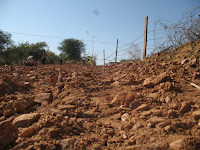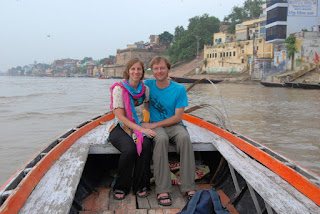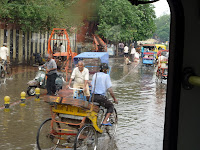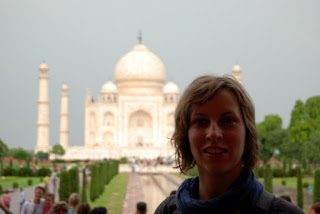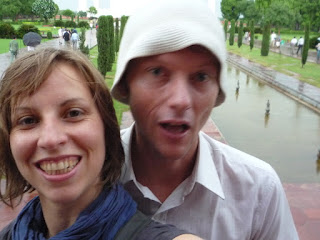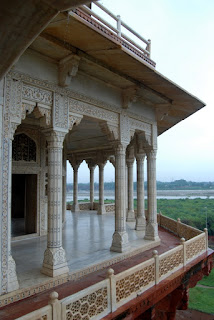Indianish Snippets
Once again, after a long hiatus, I sit down and try and write another blog about my experiences in India. This will be one that details a collection of things that have happened in connection with work, but don’t really have anything to do with work, and are quintessentially Indian. I guess it makes these events all the more incredible for me given they have such ‘serious’ ramifications, i.e. you have to interpret these as not just isolated weird experiences.
Git orf mah land
GreenOil has finally completed the purchase of some suitable land for the Power Plant near our current base in Samode, Rajasthan. This process in itself was a drawn-out one, which I may have alluded to in previous blogs. As it was, we needed to purchase two land holdings. One being the main land where the plant will be built and composting operations will take place, the other being a slice of land where an access road will be built connecting the land to a public road.
Complications started after the road land deed was signed, and we sat down with the owner of the main land. The main land was actually two plots- one of which was a tiny ‘sliver’ of about 0.11 Ha., alongside the main land. Suddenly the seller presented us with his view of the deal: “Since I am giving you the ‘sliver’ for free (i.e. the total land he was selling to us didn’t quite meet his expected selling price of 4.5 lakh per bigha) all that I ask is that I be allowed to build a house on the same size area of land on your property.”(!) Remember, GreenOil are building a Power Plant, on land acquired with funds from LGT, a major funding partner. So of course we said no way, it’s not possible, our board would never allow it. The seller, knowing now that we had already bought the road access land, was obviously in the stronger position. “OK then, if your board doesn’t approve it, then my board doesn’t approve the land sale.” At the end of the day, and at the end of all this time spent looking for suitable land, negotiating prices and brokering this land deal- what can you do? Our CEO didn’t see a way out, so now we have an agreement to let the previous owner occupy 0.11 Ha. in a location at our discretion on our Power Plant site for a period of 99 years, only he and his family can live there, he cannot sell the house, etc. etc. The current planning has his plot located in close proximity to the 600 kW generator…
A visit from the local Mafia
Monday we were back in the office in Delhi, where we receive a good number of visitors every day poking their heads in to ask directions, inquire why the German Bakery is closed, or ask for Baksheesh (a ‘gift’). Today’s visitors were some of the latter, but a rather special breed. These were representatives of the local hermaphrodite Mafia.
Hermaphrodites are something more than just a curiosity in India, they are genuinely feared. They make themselves perfectly obvious, because most people’s interaction with them takes one of two forms:
- Giving them a ‘donation’ to avoid any back luck the man-ladies might bring to them, or
- Being recipients of said bad luck (new-born babies are especially susceptible to this type of bad luck)
Normally, you encounter the hermas (if you’ll permit me such an abbreviation) in crowded places- buses, trains, etc. They follow a similar begging style to most in India. They’ll come right up to you and perhaps touch you on the shoulder, and generally let you know that they’re serious about the bad-luck givin’ if they don’t do some receivin’. So far I have avoided any bad-luck with the hermas even though I haven’t ever given them any money.
So as I said, this time our office received a personal visit from the hermas. There were two of them, demanding their baksheesh. I don’t ever hand over baksheesh to religious types, and I figure these guys are in the same league. My boss though, is both more religious and has less patience to wait for these types to leave, so he handed over quite the sum of Rs 100. On this occasion though, that wasn’t enough. There then began an animated discussion about the ‘amount’ of baksheesh that would be required. Words like ‘diwali’ (the biggest Indian festival of the year- just finished) were bandied about and some discussion ensued, until my boss then asked me for Rs 500 (as he didn’t have any more cash on him). That was handed over. But still the ‘negotiations’ didn’t stop. Turns out the current going rate for avoiding the curse was Rs 2,400.
Let me tell you a little more about what a curse from the hermas involves. As I was telling you earlier, a normal encounter with a herma in a public place where you don’t pay the non-curse fee results in a simple curse, which involves the exhibition of cursing genitalia. I would also suspect that if you’re sitting down in the train when said cursing takes place it could be a little uncomfortable. Cursing on an organised scale though, is a little more sinister. The herma mafia normally live together, using their daily gains to eek out a comfortable life for all (all hermas, that is). Therefore, they also have quite a curse-armoury at their disposal. So non-payment generally results in the threat of a visit of all the local hermas, who will return and give you and your office some kind of super-curse (accompanied, one suspects by a super-exhibition of cursing genitalia). To expand on an earlier point, one of their best money-making enterprises involves the hermas searching out new born babies and threatening the genitalia revelation. Normally the frightened family hands over whatever is necessary.
Our negotiations went on- the hermas played some kind of a good-herma/ bad-herma routine, with one threatening to bring the bad-luck curse down on our operation, and the other appealing to the good nature of our CEO to hand over some more cash- after all, it did have something to do with his religion, this whole curse thing. Every now and again they addressed me, with the word ‘money’, but I had had enough of this whole routine by now (donations out of a religious respect ok, but you can’t really demand a certain minimum price for not cursing people and still hold any sort of standing with me). I think they ended up getting about Rs 700 before moving onto the next poor sod.
What happens when Delhi tries to stamp out corruption
Yesterday in the office saw what I thought was just some normal ‘news of the day’ from my CEO in the morning. Apparently a high court judge had had enough of the reports of corruption amongst government officials and police officers and had decided to do something about it: today had been declared “condemn illegal buildings day”. In Delhi people build when they have enough money to. They often don’t own the land, and rarely do they get permits to be able to construct a structure (and most don’t get proper builders to do it either). ‘Please report illegal building’ plead the signs around housing areas. So the police yesterday had been charged with a massive operation to ‘shut down’ any illegal building that they could find. Now normally, of course, the police (and local government officials) are also supposed to shut down illegal buildings. And I’m sure that enough illegal building operations get reported. However, usually the shutting down procedure involves a trip to the illegal building site, where some negotiations take place, and some money changes hands. It works, everyone is happy (apart from the law-abiding neighbours). On this day, however, the police had to look like they were doing a proper job.
So the day passed relatively normally until about 2pm, when our landlord appeared at the office entrance, and promptly pulled the security shutter down, leaving me with no front exit and a darkened room. My CEO (who had been at lunch), came in through the back way telling me that it was complete chaos outside, and that all the other offices in our block had their shutters down and were locked up. Our landlord was frantically negotiating with the scores of police that had turned up not to knock a hole in the wall or put up a condemned sticker. A condemned sticker (or a hole in your wall), even if you had all the correct papers, meant a forced trip to the local government office, and possibly weeks of wait before that condemned sticker was repealed. You desperately wanted to avoid that. After 1 hour of talks the shutter was pulled up again to reveal just how many officers + beat cops (about 200) were standing around outside. They were going through the local neighbourhood and bashing holes in the walls of unoccupied buildings, and I guess they could have reasonably expected some resistance. Mostly I suppose it was the way they chose to conduct this operation that floored me while I was sitting inside my office for that hour trying to work as quietly as possible and wondering what would happen if some cop decided to open the shutter. But then I guess they thought this is the only way anything will get done.
My boss says that the business of bribes and illegal building should return to normal tomorrow.
[Samode, 10.11.2011]







